In the first installment of this “AK Rifle 101 for New Gun Owners” series, we talked briefly about what AK is and recounted the farcical purchase of my AK rifle and why you shouldn’t do it that way. If you haven’t read that one, consider giving it a look. If nothing else, it may give you a laugh at my expense. As I said in the first article in this series, this is not intended to be an “everything AK” kind of endeavor. Entire books are devoted to that. I’m hitting the high points, at best.
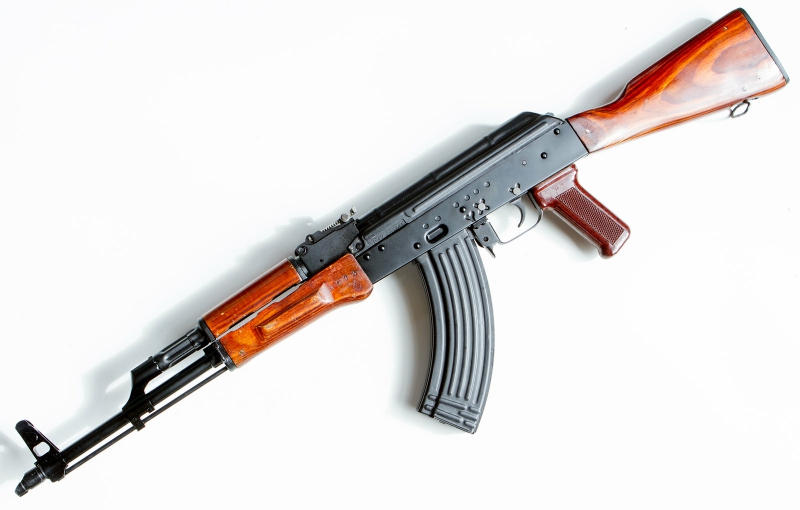
In this second installment of a three-part series, we’ll talk about features of the AK system that may or may not appeal to you. First up is caliber.
AK Rifle Calibers
I’m only talking about carbines here, so I’ll limit things to three choices: 7.62×39, 5.45×39, and 5.56×45. AK style guns chambered in pistol or full-size rifle calibers will have to wait for another day.
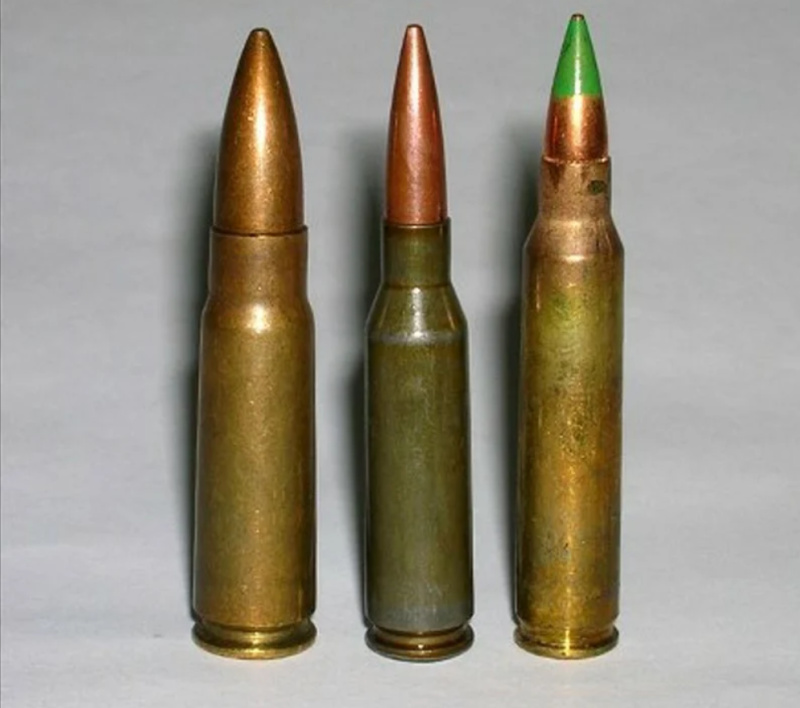
7.62×39
This is the classic AK-47/AKM caliber. It has been in use since right after World War II, beginning with the Russian SKS rifle. It’s the most powerful of the three in terms of energy on the target. It’s plentiful, cheap (as far as ammo can be these days), and reliable. You can easily hunt deer or wild hogs with it if you’re so inclined.
It has a reputation for being less than accurate, but that’s a relative assessment. It is generally a bit less accurate than the other two choices, but the difference is MAYBE an inch or so at 100 meters. None of these guns are meant to be precision rifles. 7.62×39 is as accurate as you need it to be out to 300 meters with iron sights and 500 or so with a scope.
The recoil is heavier than the other two but, again, that’s a relative thing. I think of it as a solid recoil more than anything. My deer rifles kick much harder. 7.62×39 gives me a satisfying “thump” and is my favorite of the three, and not just because that’s what my rifle is chambered in. I like the versatility, availability, and price.
5.45×39
This caliber was introduced by the Soviets in the mid-1970s for the then-new AK-74. It’s the Russian version of the 5.56×45 cartridge used by the US military. Some say the Soviets were afraid the American cartridge had some special advantage they might be missing out on. No idea if that’s true.
Either way, the 5.45 is nice cartridge. It’s a higher velocity round than the 7.62×39, shoots flatter, has a longer range, has less recoil, and is generally more accurate. It doesn’t hit as hard as the older cartridge but it’s still a great defensive round and people do use it to hunt deer and wild hogs. Its lighter weight and less bulk mean you can carry more ammo if you’re so inclined.

The real downside to the 5.45 is the price and lower availability. Simply put, the Soviets didn’t drop the 7.62×39 in favor of the 5.45. They and their fraternal socialist allies made both and the supply of the former dwarfs that of the latter. The Russian military still uses both cartridges. Because there isn’t as much of the 5.45, it’s harder to find and it generally costs more. You decide for yourself.
5.56×45 (.223 Remington)
This is the same round used by the US and NATO. 5.56 is the NATO designation and .223 Remington the civilian. Any rifle chambered in 5.56×45 will accept .223, though you shouldn’t do it the other way around because of minor, but important, differences in the chamber. AKs chambered in 5.56 are relatively new to the market but they seem to be gaining in popularity.
5.56 and .223 are readily available due to the ubiquity of the AR-15 family of rifles. 5.56 is a proven cartridge with performance similar to the Russian 5.45. It’s just a lot cheaper and easier to find. Some purists refuse to buy an AK rifle in 5.56, but it looks like a winning combination to me. I still prefer my 7.62×39 though. If I want to shoot 5.56, I have ARs for that.
On a practical note, I once saw a test comparing the effect of 7.62×39 and 5.56×45 on cinder blocks. The 5.56 punched little 5.56 mm holes in the blocks. At the same range with the same number of rounds, the 7.62×39 broke the block into five or six distinct pieces. That doesn’t mean one is better or worse than the other. They just have different effects.
AK Rifle 101: Ergonomics
To be honest, AK rifle ergonomics aren’t that great, especially when compared to the current crop of AR-15s. Even the newer AKs have real limitations. They are better than the older models, but some real challenges still exist. Let’s start at the buttstock and work our way forward:
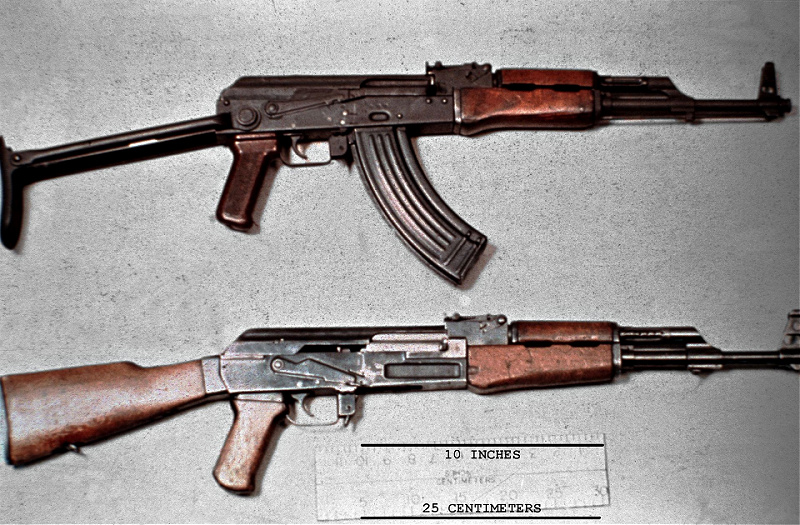
Stocks
I’m totally not a fan of the standard AK rifle stock. Yeah, the wood looks cool and all, but they are short and don’t really fit me. My AK came with a cheap polymer stock, but it was made to the same basic dimensions as a standard AK rifle stock. I couldn’t get a good cheek weld and I felt scrunched up when firing. I just didn’t like it. But modern American industry makes some very nice adjustable aftermarket stocks, which fixed that problem.
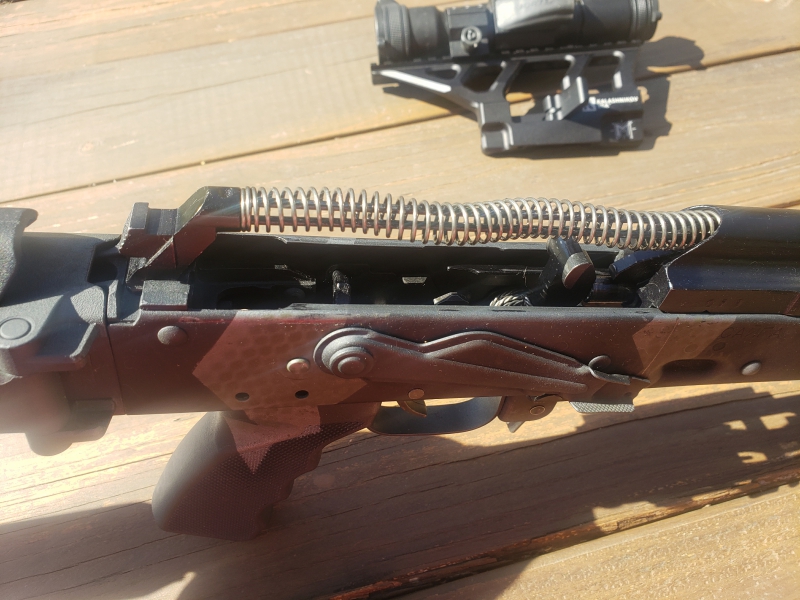
You may like the standard AK rifle stock. Good on ya if so. If not, you can find telescoping and folding stocks (mine does both) and you can even install an M4 adapter that lets you take advantage of all the great AR stocks on the market. One thing the stocks don’t have, as opposed to the AR platform guns, is a buffer spring. The AK rifle doesn’t operate that way. The only buffer is the recoil spring that operates the bolt. The only wood stock I think I would keep is the plum-colored version. That’s a unique look that I really dig.
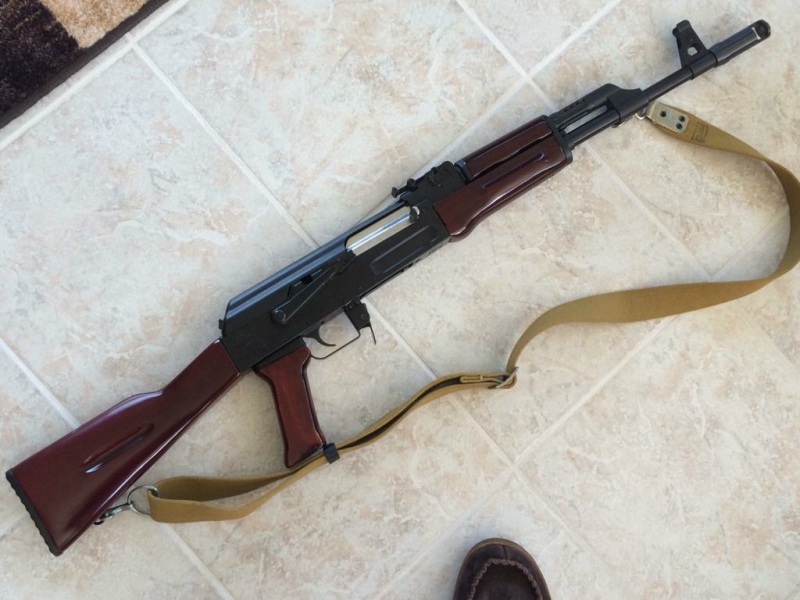
There are various surplus folding stocks out there too. Some folks like them, and some don’t. I have no experience with them, but the information is out there.
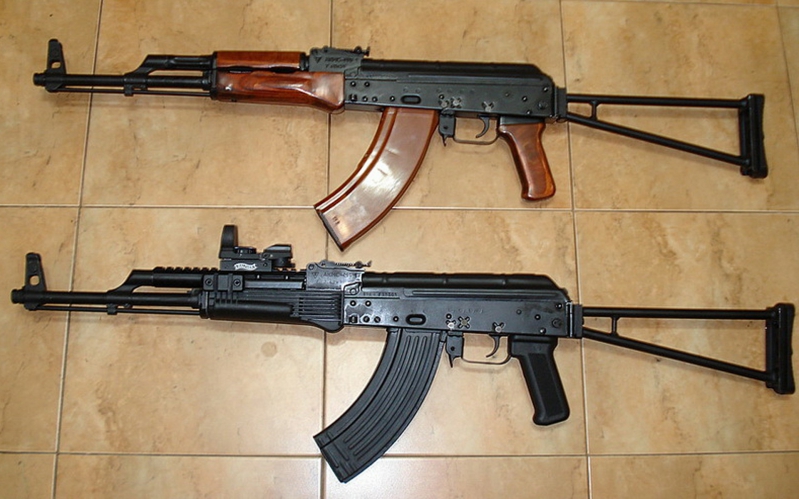
Pistol Grips
Again, the standard AK grips are just OK. They’re fine, if a little thin for my taste. The old ones are wood, but there are plenty of polymer options out there too. There are also lots of aftermarket grips available in different sizes and whatnot. I kept the polymer grip that came with mine but I’m thinking about adding some grip tape to it. I recently saw someone with tennis racquet grip tape, and it seemed to work very well.

Safety Lever
The Kalashnikov safety lever is simple and effective. Located on the right side of the receiver, it moves up for safe, which blocks the action from cocking as well as the trigger if the rifle is already cocked. The down position unlocks the action and the trigger so the rifle can fire. Military grade AKs have a third position for automatic fire.

That’s all fine, but the lever is impossible to operate without breaking your firing grip if you’re right-handed. If you’re a lefty, you’re good to go, except you might catch hot brass in the face when you pull the trigger. But the aftermarket has come to the rescue. An enhanced safety lever is available with an extra “shelf” that makes it simple to operate with the trigger finger while not breaking your grip. Newer model Russian AKs have adopted this feature, as have many newer civilian rifles. I haven’t upgraded mine. I might or might not. It isn’t really a big deal to me. But you do you.
Accessory Rails, or Lack Thereof
One of the great things about the AR-15 is its modularity. You’re likely to find as many different setups as there are owners, or even more since many of us have more than one. There are different ways to set up an AK rifle, but you have to work harder for it. A nagging problem with putting optics on AKs is that the top dust cover has to be removed to field strip the rifle. The dust covers are not part of the receiver so it’s very difficult, if not impossible, to keep an optic on zero, even if you install an aftermarket dust cover that has a rail on top. It just isn’t stable enough. I won’t say it’s impossible since I haven’t seen every dust cover out there, but it has proven difficult in the past.
The solution for years has been a rail mounted on the receiver’s left side on which an optic mount is installed. The mount includes a picatinny rail that is suspended over the dust cover for installing an optic. Less than ideal but it works as long as you have a properly installed side rail and a quality mount. A word of caution: most mounts that fit the side rail suck. Sorry but they just do. If you pay 30 bucks for such a mount, well, you’ve wasted your 30 bucks. I found that out the hard way. I then paid a little over a hundred bucks for one that had good reviews. It broke a year later.

Honestly, the only one I can recommend is the RS Regulate mount, which runs about 150 dollars. The problem is no one can keep them in stock. I have literally been looking for one for two years. I finally got fed up and bought a promising looking mount from Kalashnikov USA for about the same price as the RS Regulate. I haven’t used it enough to say whether it was a good purchase or not. It has held zero so far, but I can’t speak to its long-term durability.
The new Russian Army guns have receiver mounted dust covers that lift up instead of being removed entirely. They are supposedly stable enough to mount an optic on the integral accessory rail. I have heard good things but have no experience with them. They are available as aftermarket parts and I expect new American made guns will soon have them as a standard feature too.

Magazine Release
The AR-15 mag release is just about perfect ergonomically. Not so the AK rifle. It works fine but I’m not really a fan. It’s a thumb operated steel lever right in front of the trigger guard. It is ambidextrous but it tears up my thumb. I tried a couple of enhanced releases that attach to the original, but none worked very well. I eventually just decided to wear gloves when I shoot. If that makes me a wuss, so be it. There are alternate ways to operate the mag release, demonstrations of which you can find on various YouTube Channels which will be discussed in the last installment of this series.
Magazines
As with the AR-15, there are lots of magazine options, some good, some not so much. Surplus Russian, Romanian, Polish, and Bulgarian mags are available, and I’ve had good luck with them. The Russian bakelite mags look really cool, but I haven’t bought any because they’re very pricey.
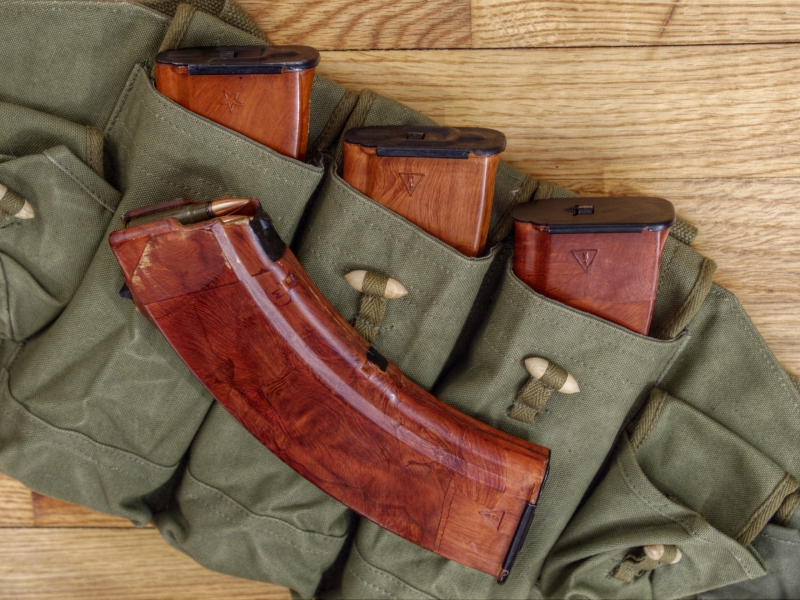
There are also some nice domestic polymer mags out there from companies like Magpul, SGM Tactical, US Palm, and Lancer. I’ve used all of those and I like them. I’m sure there are other good ones.
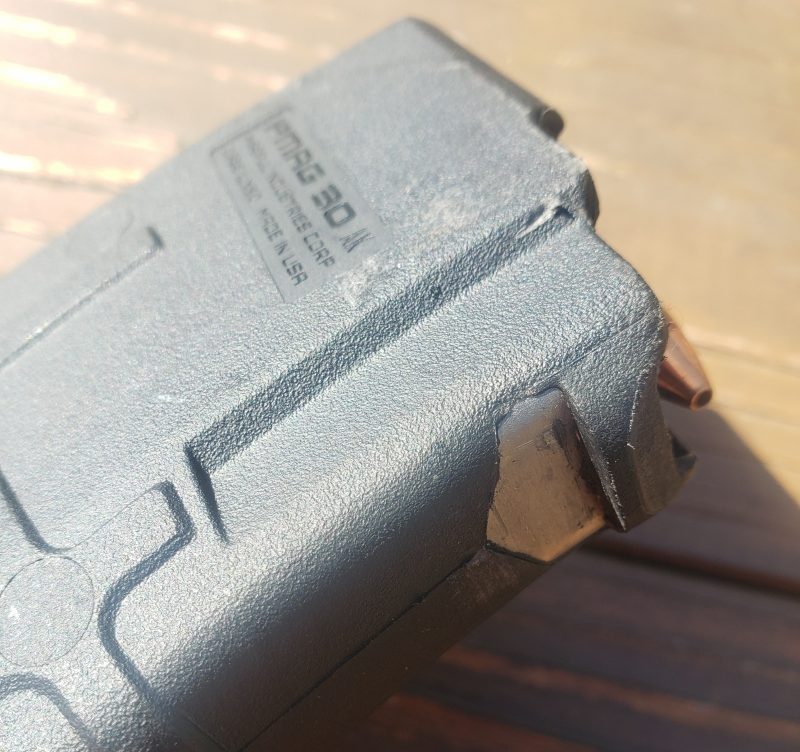
With polymer mags, I recommend the ones with steel reinforced feed lips because you will tear up the polymer over time, even if you don’t mess up the reload (which you will, at first). If you buy a Saiga conversion, you can only use Saiga compatible mags unless the gun is equipped with a “bullet guide.” It’s also necessary for Molot VEPR rifles. It’s an inexpensive part that installs in the bottom of the receiver, just behind the barrel.
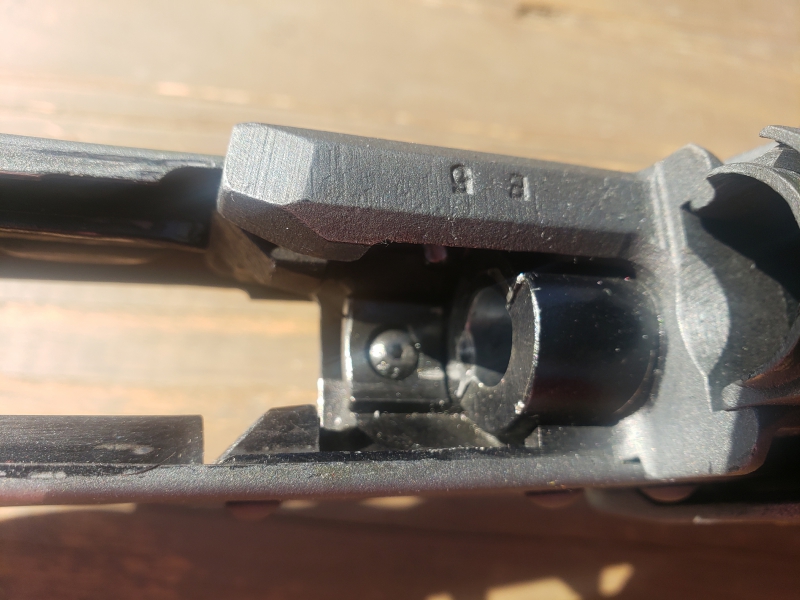
Hand Guards
The original Kalashnikov handguards are also wood. Cool looking but not practical if you want modern accessories. They also get pretty hot when you’re shooting. As I said before, wearing gloves while shooting an AK is a good idea. But, like the stock and pistol grip, there are plenty of aftermarket handguards available. Modern AKs come with polymer handguards, some with limited rail systems and heat shields. Mine was a cheap polymer affair with no heat shield. I replaced it as soon as I could with a Magpul Zhukov extended handguard with M-Lok capability for accessories. It’s much better, if a little heavy.

Accessory Rails Part Deux
As I mentioned, the original AK rifle handguards were wood. To be fair, there was no such thing as an accessory rail at the time and there weren’t really any accessories to attach to a standard infantry rifle anyhow. Today, there are more accessories than I can keep up with, but no way to mount them on a wooden handguard. Like the stock and grip, there are plenty of aftermarket handguards available and many new AKs include upgraded accessory-ready handguards as standard equipment. So, it’s now possible to mount optics, lights, lasers, foregrips, or whatever you might want on your rifle. Because of the AK’s basic setup, though, these handguards don’t offer the flexibility of the AR platform. That’s just how it is.
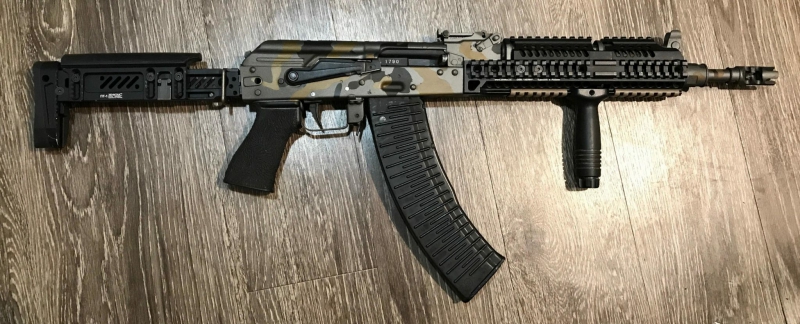
Sights
Standard AK sights are adequate. That’s really about the best thing I can say about them. They consist of a rear notch with an elevation adjustment. They are preset in hundreds of meters, with many maxing out at an extremely optimistic 800 or 1000 meters. My advice is not to bother. If you need to hit something at that range, you better get another rifle. The front sight is a shielded post adjustable for elevation and windage.
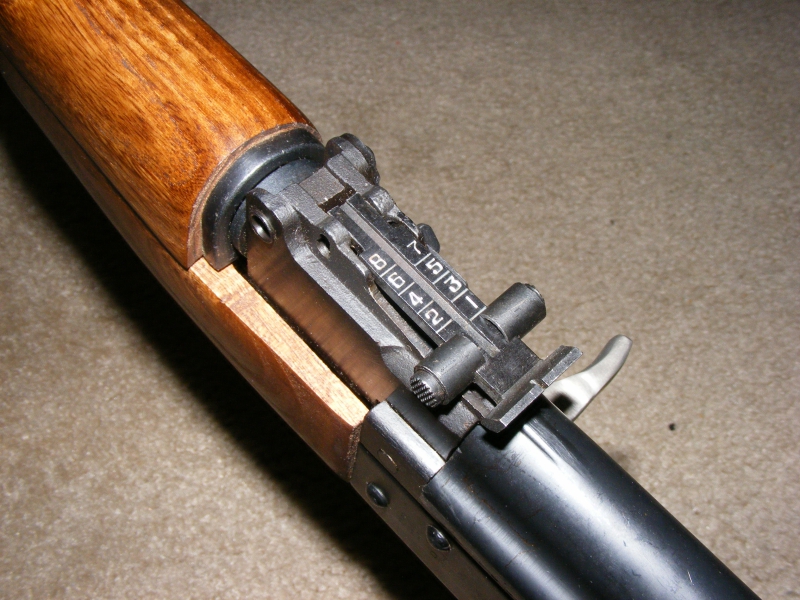
There are a couple of problems with AK sights, both of which contribute to the perception of inaccuracy.
First, the rear sight block is located at the front of the receiver, roughly halfway between the buttstock and the muzzle. That gives it a short sight radius compared to most other rifles, including the AR-15. A basic rule of thumb is that a longer sight radius contributes to accuracy, all other things being equal. As I said before, quality AKs are as accurate as you need them to be, but the short sight radius makes the ceiling a bit lower than it might otherwise be.
Second, the sights on AK rifles are sometimes canted to one side or another. Sometimes badly so. You usually see that on the cheaper brands, but it can happen to others. It’s common enough that you should be wary of it. This happens because the sight blocks are pressed onto the barrel. Imprecise tools or shoddy workmanship can lead to them not always being exactly right. The rear sight on my Saiga is canted just a bit to the right. You can’t tell unless you have the rifle to your shoulder, but it’s there. I’ve found, however, that it doesn’t negatively affect how well I shoot it. I considered trying to get it fixed but have decided it’s not worth the effort or expense, if it could be done at all. I doubt it would have much impact on the rifle’s performance. But you should always check for it because sometimes it’s pretty egregious.
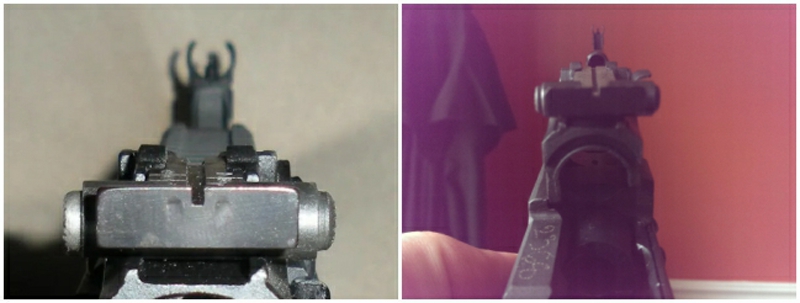
I already discussed the mounting of optics, so I’ll only add that I’ve seen some folks who have replaced the entire rear sight with a low-profile red dot. I’ve never used one of those, but I took a training course a couple years back where a guy performed very well using that setup.
Muzzle Devices
I don’t have much advice here because there are a bunch of choices out there, including muzzle brakes, flash hiders, compensators, and combinations of those. There are also plenty of suppression options. Many AK rifles have a threaded barrel, including the Arsenal Saiga conversions. Because I unknowingly, and naively, went with a company on the verge of bankruptcy, they shipped mine out without a threaded barrel. They just slapped on a barrel shroud forward of the front sight and that was that. I intend to have it done, and I know who I want to do it, I just haven’t yet.
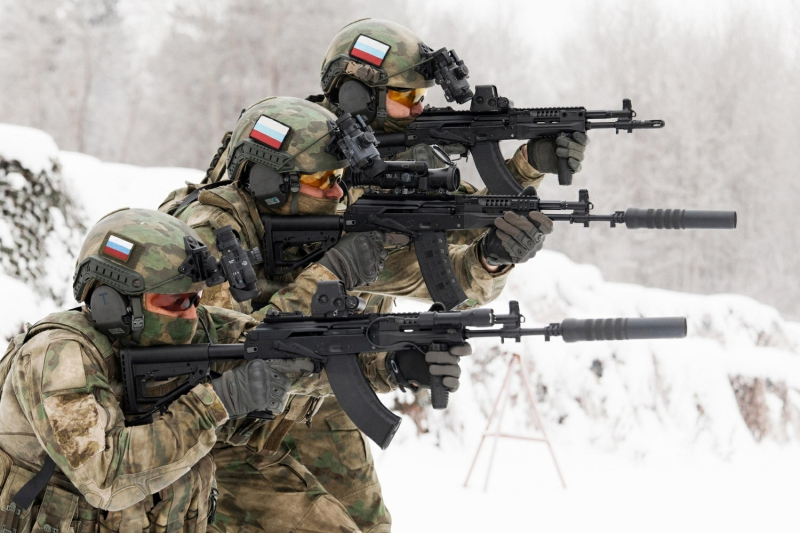
You should at least have a flash hider, though I will admit that seeing my rifle shoot a foot-long flame out the muzzle when shooting at dusk is pretty damn cool. Of course, you can always take it off for that. A muzzle brake will reduce the recoil significantly, but it will also make the already-loud AK even louder. Personally, I don’t feel the need for a brake, but I want the flash hider. Again, you do you.
There are other things to consider when buying an AK, like barrel length and quality, but that’s a whole other discussion. All kinds of info is available out there on the merits of various barrels. All you have to do is look. But this ought to give you enough to start thinking about what you want or don’t want.
Next week, with the final installment of the “AK Rifle 101 for New Gun Owners” series, we will talk about why you might want an AK, where to look for helpful information, and why I love mine enough to name her.


